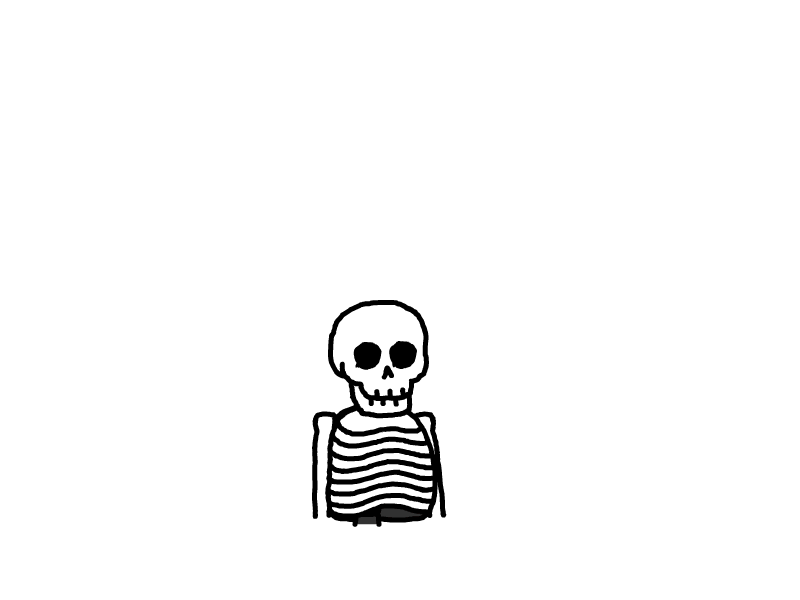
[课程资料] 高级统计方法书后习题(七)
本系列内容为《统计学习导论——基于R应用》(机械工业出版社)部分课后习题答案。
本章为7.9节习题答案。
声明:本博客中的习题分享仅供学习和参考之用。请勿将其用于任何形式的学术欺骗、抄袭或违反学术诚信的行为。尊重知识,诚实学习。
如果您发现文章内容中任何不妥或错误之处,请随时通过联系方式或评论功能与我交流,以便我进行改正和完善。
一、概念题
7.9.1
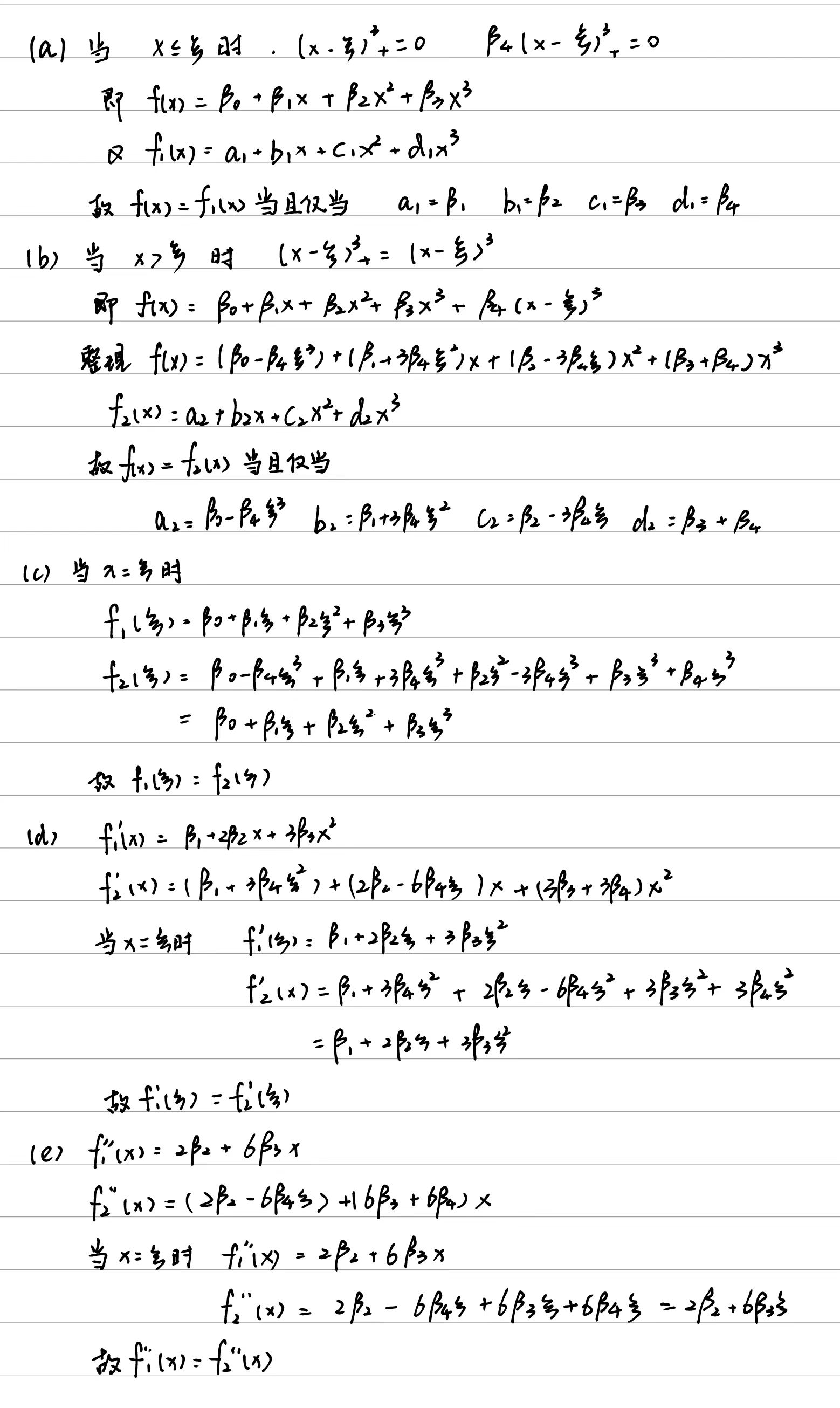
7.9.2

7.9.3
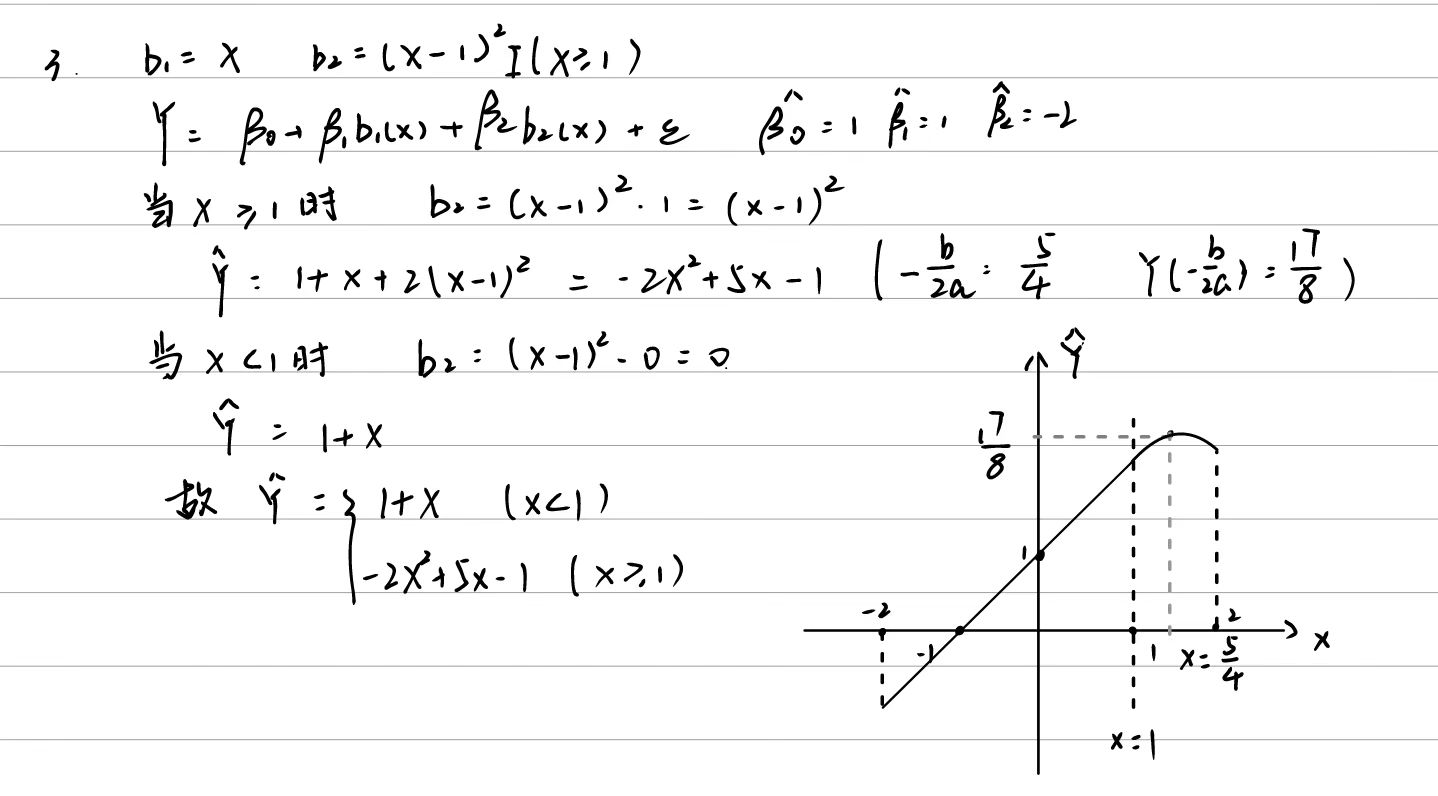
7.9.4
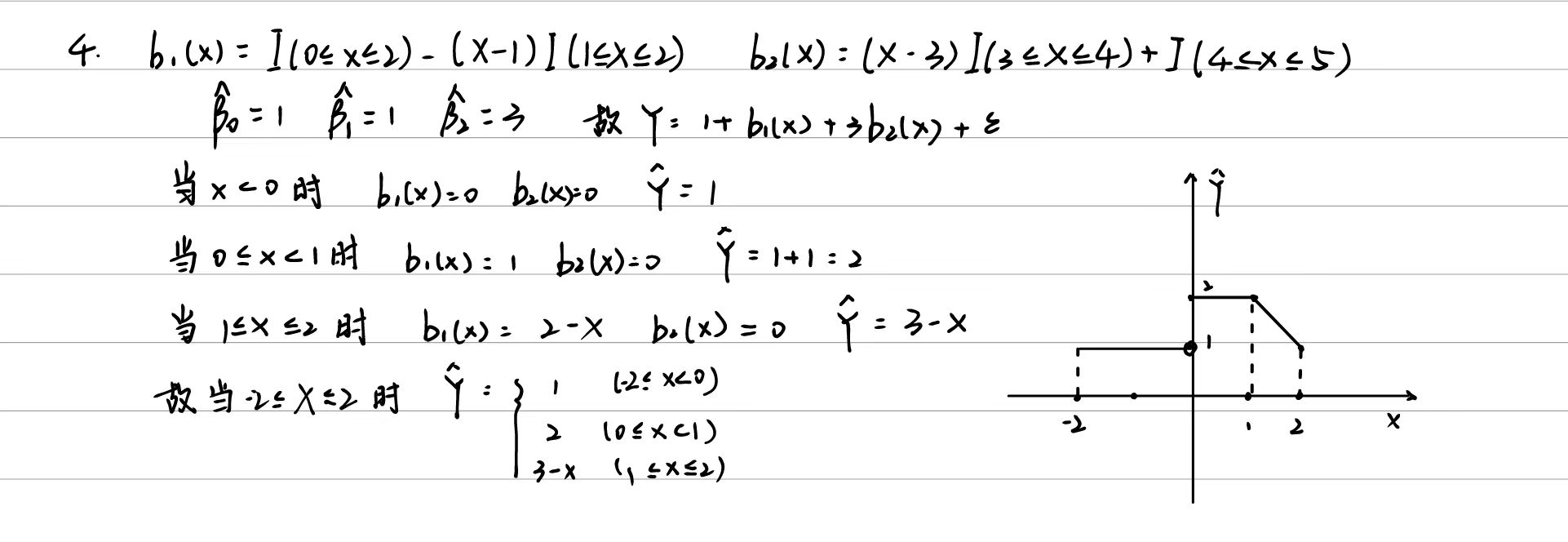
7.9.5
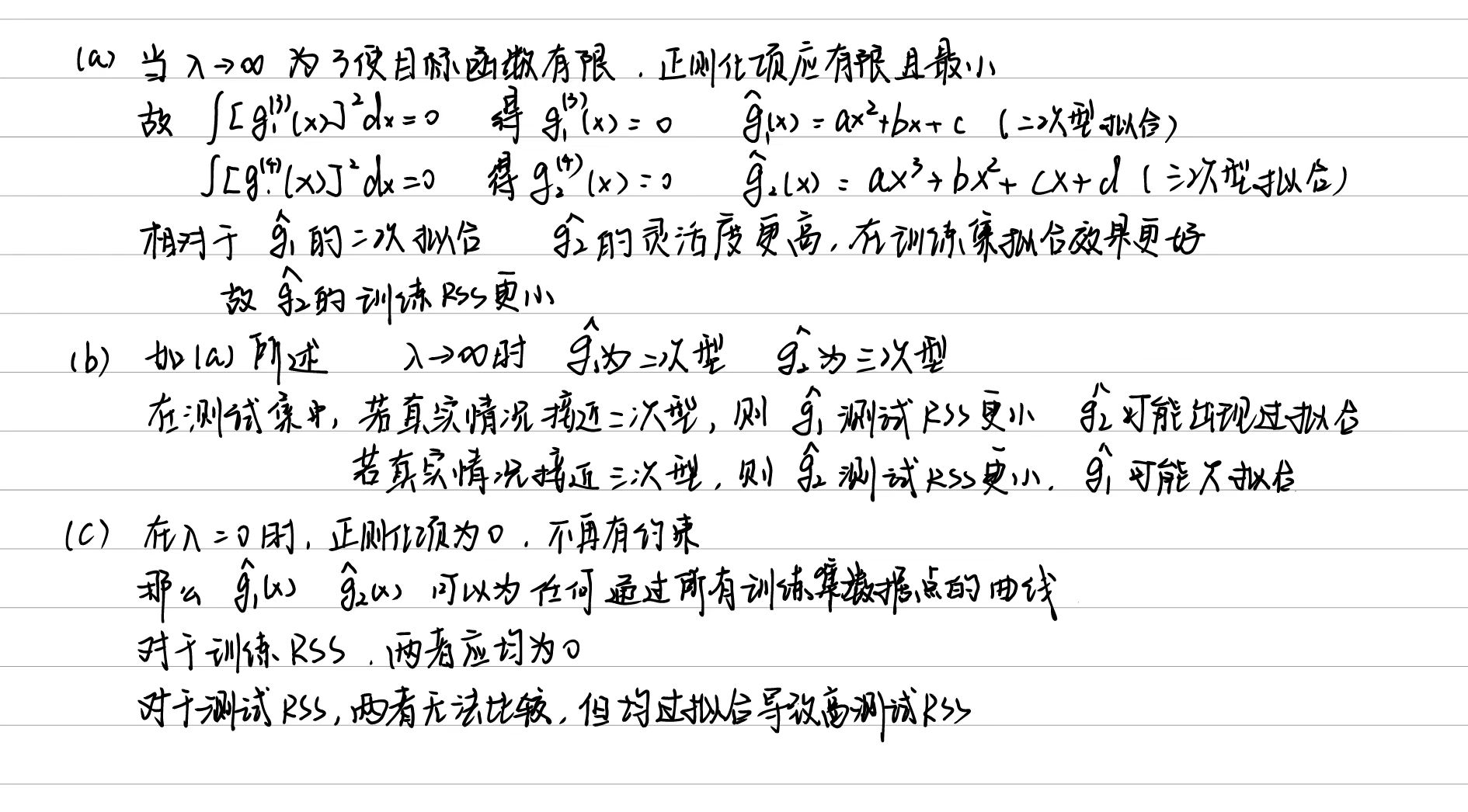
二、应用题
7.9.9
-
(a)
# 9.(a) library(MASS) model = lm(nox~poly(dis, 3), data = Boston) summary(model) plot(Boston$dis, Boston$nox, xlab="Dis", ylab="Nox") dis_seq = seq(min(Boston$dis), max(Boston$dis), length.out=length(Boston$dis)) ## 设置平滑的dis序列 nox_pred = predict(model, newdata = data.frame(dis=dis_seq)) ## 进行预测 lines(dis_seq, nox_pred, col="red") ## 绘制三次回归预测图像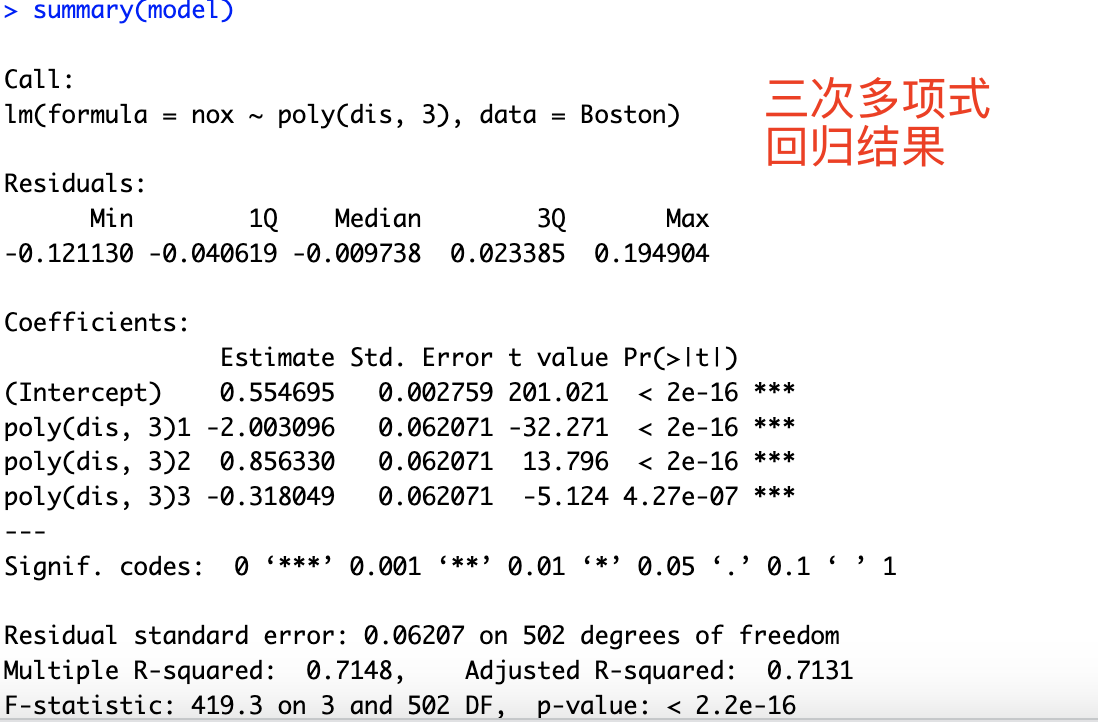
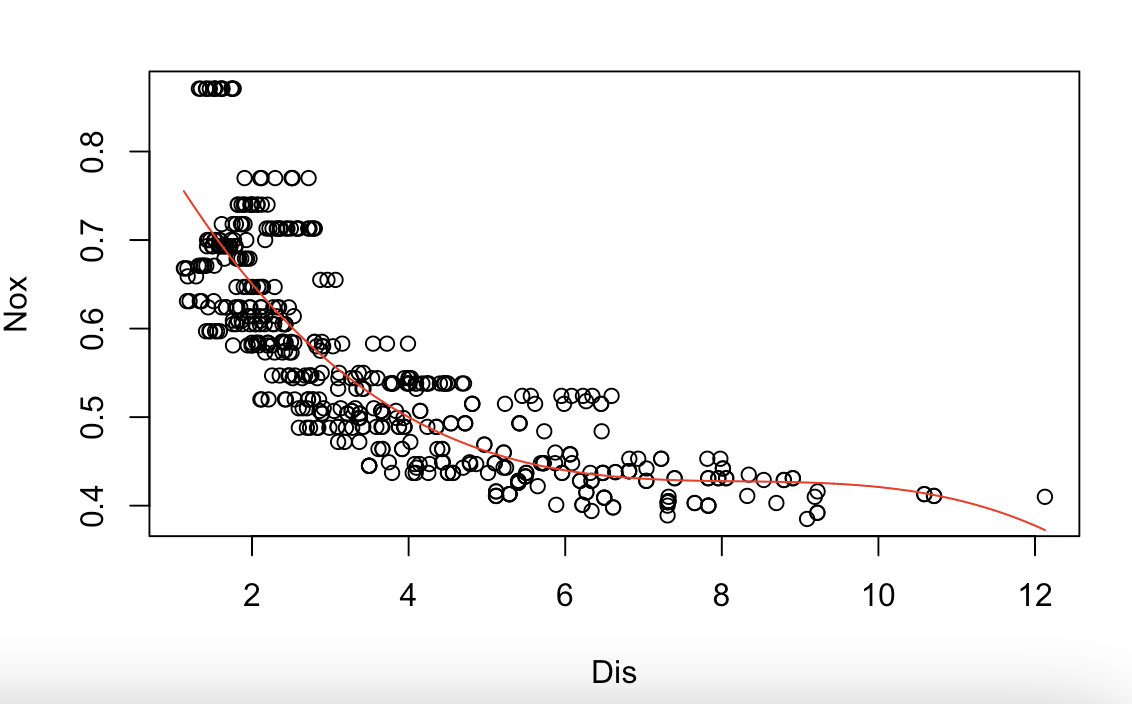
-
(b)
# 9.(b) rss = numeric(10) # 10个参数的向量(数组) plot(Boston$dis, Boston$nox, xlab="Dis", ylab="Nox", col="grey") colors = rainbow(10) # 10种颜色 dis_seq = seq(min(Boston$dis), max(Boston$dis), length.out=length(Boston$dis)) for(i in 1:10) { model = lm(nox ~ poly(dis, i), data = Boston) nox_pred = predict(model, newdata = data.frame(dis=dis_seq)) lines(dis_seq, nox_pred, col=colors[i], lwd=2) rss[i] = sum(residuals(model)^2) } legend("topright", legend = 1:10, col=colors, lwd=2, cex=0.5) plot(1:10, rss, xlab="Degree", ylab="RSS", type="b")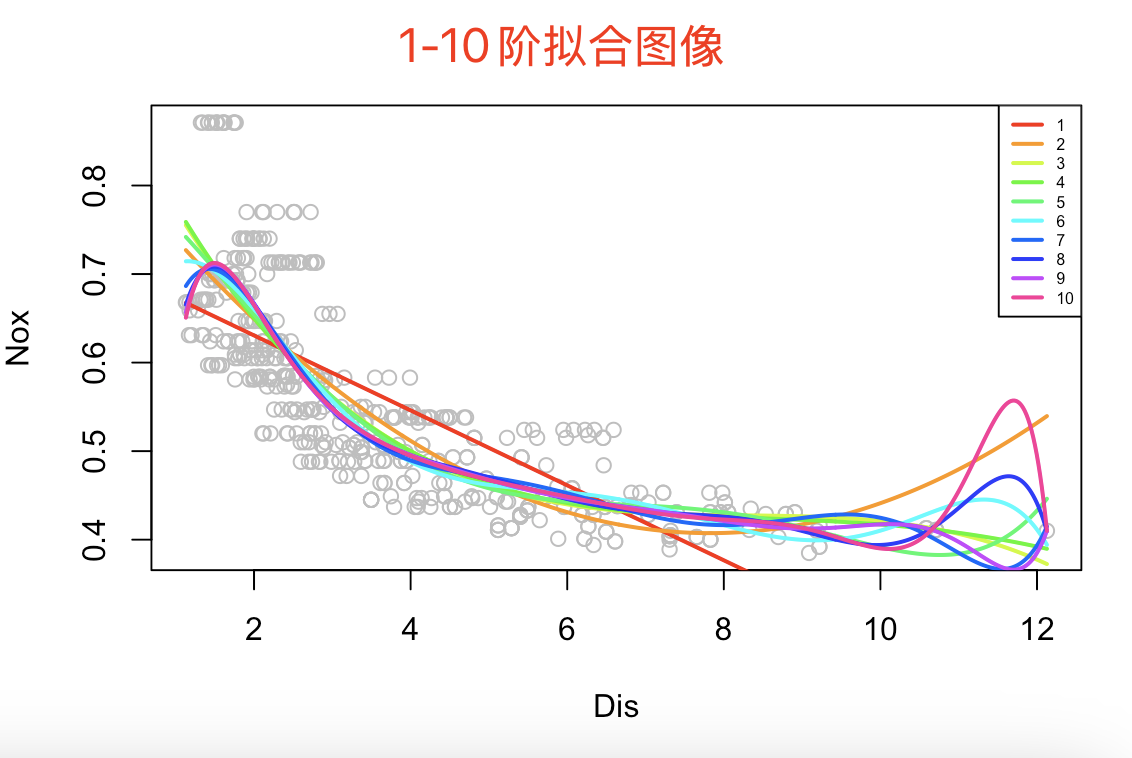

-
(c)
# 9.(c) library(boot) set.seed(1) cv.mse = numeric(10) for(i in 1:10) { glm.fit = glm(nox~poly(dis, i), data=Boston) cv.mse[i] = cv.glm(Boston, glm.fit, K=10)$delta[1] } plot(1:10, cv.mse, xlab="Degree", ylab="cv-MSE", type="b") points(which.min(cv.mse), min(cv.mse), pch=1, col="red") ## 找到使MSE最小的阶数 ## 在图中可以看出当阶数为4的时候交叉验证均方误差最小,所以4阶模型最优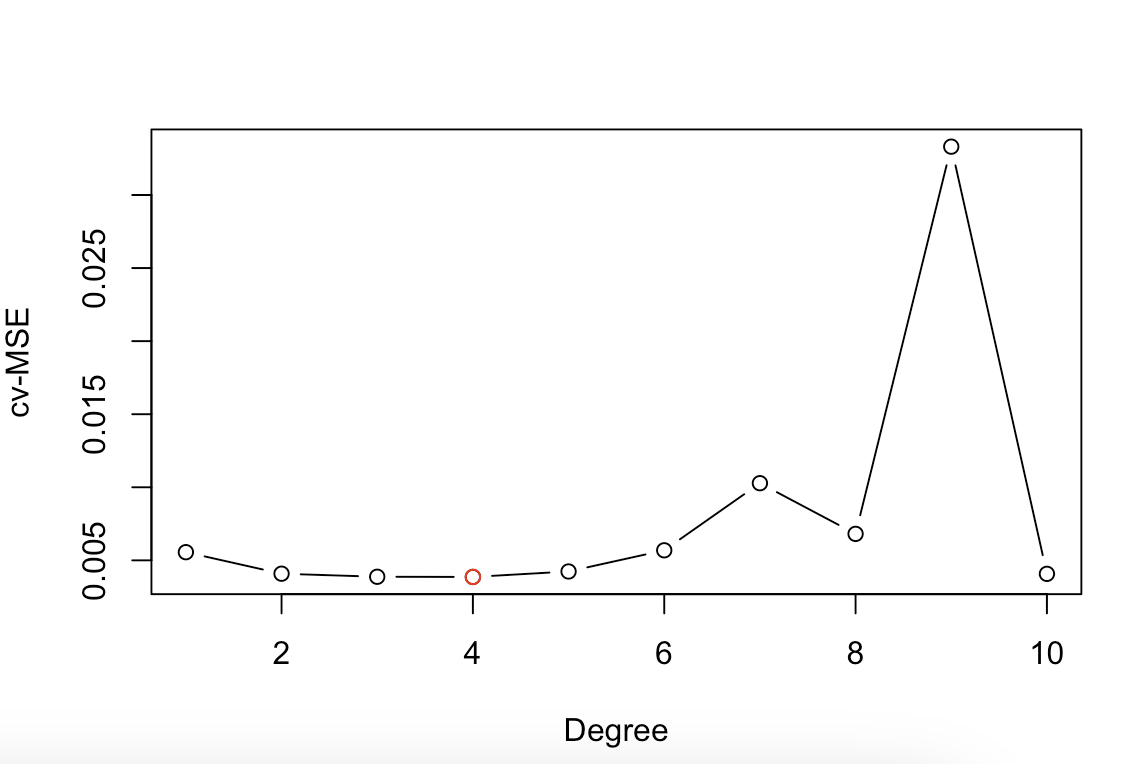
-
(d)
# 9.(d) library(splines) ## 当前自由度(df)要求为4,如果选择3阶(三次样条),那么结点数量为4-3=1个 ## 这里我们选择结点放在中位数位置 knots = quantile(Boston$dis, probs=0.5) knots model = lm(nox ~ bs(dis, df=4, knots=knots), data = Boston) summary(model) dis_seq = seq(min(Boston$dis), max(Boston$dis), length.out=length(Boston$dis)) nox_pred = predict(model, newdata = data.frame(dis=dis_seq)) plot(Boston$dis, Boston$nox, xlab="Dis", ylab="Nox", col="grey") lines(dis_seq, nox_pred, col="red", lwd=2)

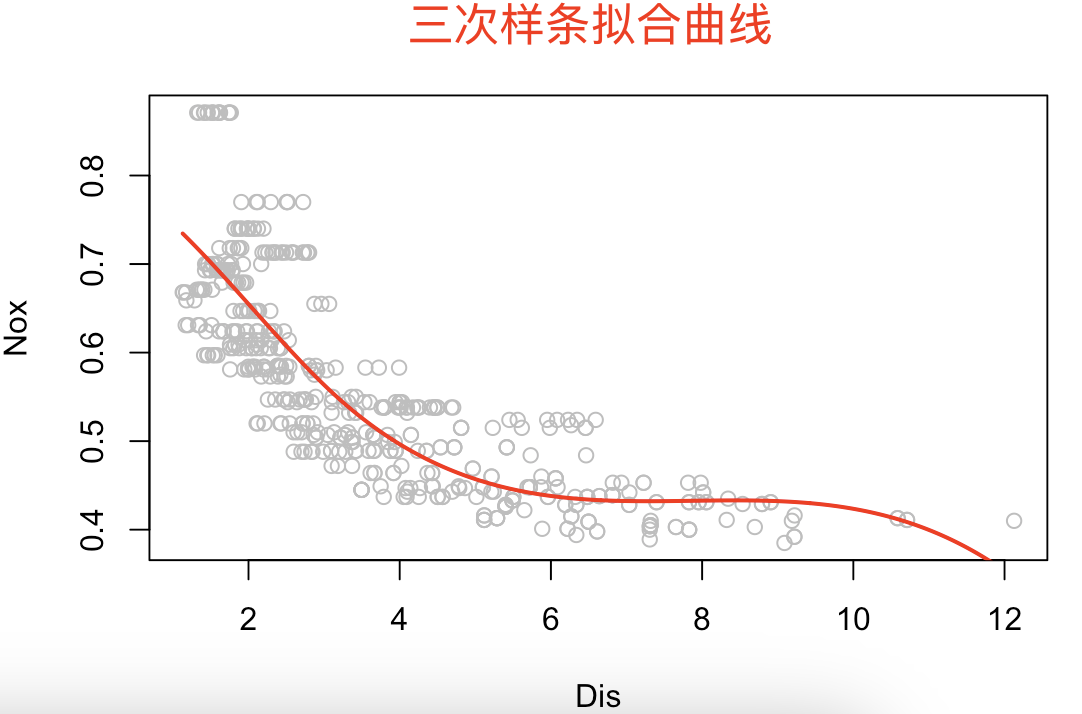
-
(e)
# 9.(e) # 选择df=4~10的区间 rss = numeric(10) plot(Boston$dis, Boston$nox, xlab="Dis", ylab="Nox", col="grey") colors = rainbow(7) # 10种颜色 dis_seq = seq(min(Boston$dis), max(Boston$dis), length.out=length(Boston$dis)) for(i in 4:10) { model = lm(nox ~ bs(dis, df=i), data = Boston) nox_pred = predict(model, newdata = data.frame(dis=dis_seq)) lines(dis_seq, nox_pred, col=colors[i-3], lwd=2) rss[i] = sum(residuals(model)^2) } legend("topright", legend = 4:10, col=colors, lwd=2, cex=0.5) plot(4:10, rss[4:10], xlab="Degree", ylab="RSS", type="b") ## 随着df增加,模型拟合效果更好,RSS更低(但是可能出现过拟合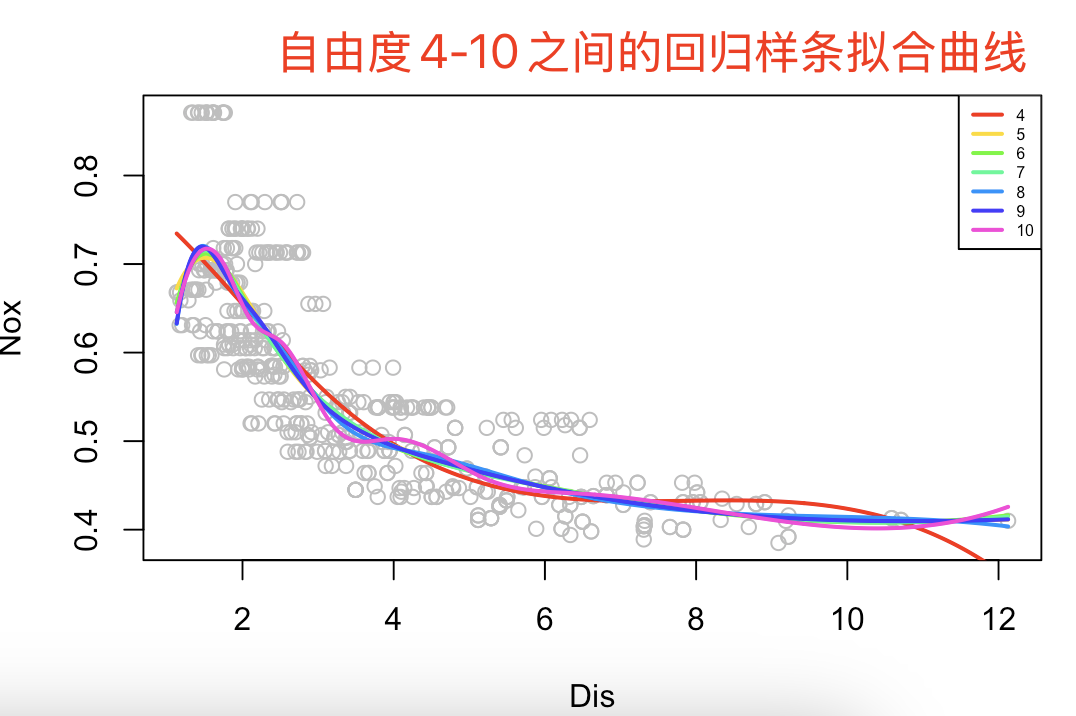
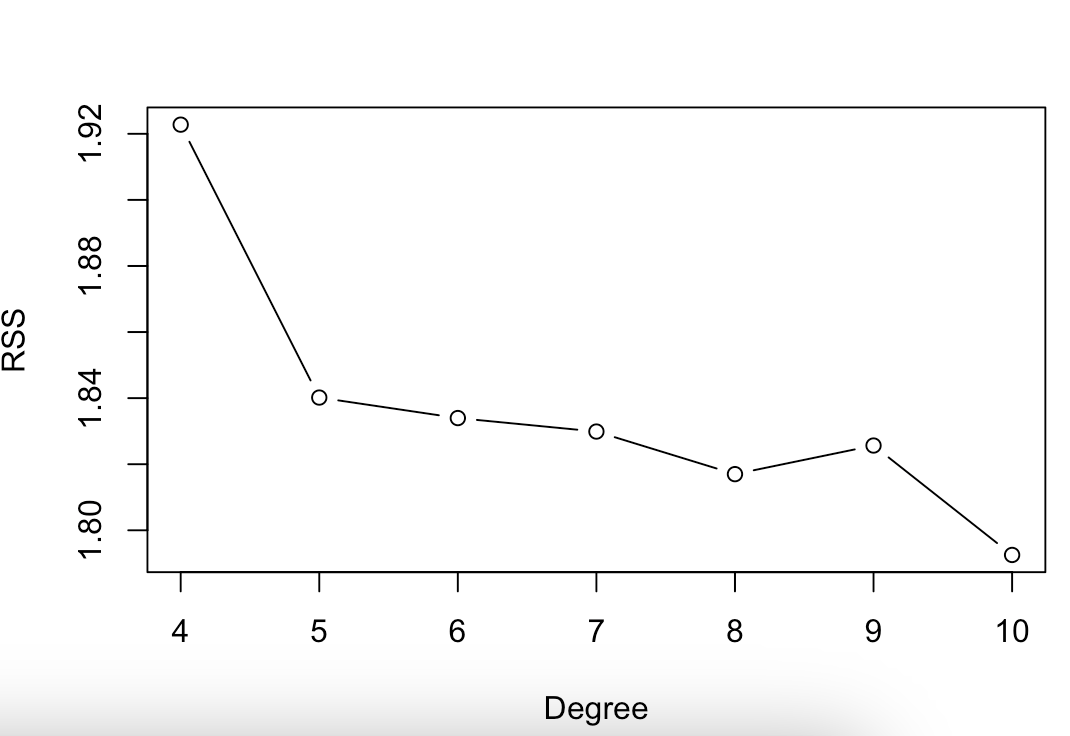
-
(f)
# 9.(f) set.seed(1) cv.mse = numeric(15) for(i in 1:15) { glm.fit = glm(nox~bs(dis, df=i), data=Boston) cv.mse[i] = cv.glm(Boston, glm.fit, K=10)$delta[1] } plot(1:15, cv.mse, xlab="Degree", ylab="cv-MSE", type="b") points(which.min(cv.mse), min(cv.mse), pch=1, col="red") ## 由图中可以得出阶数为10的时候交叉验证均方误差最小,拟合效果最好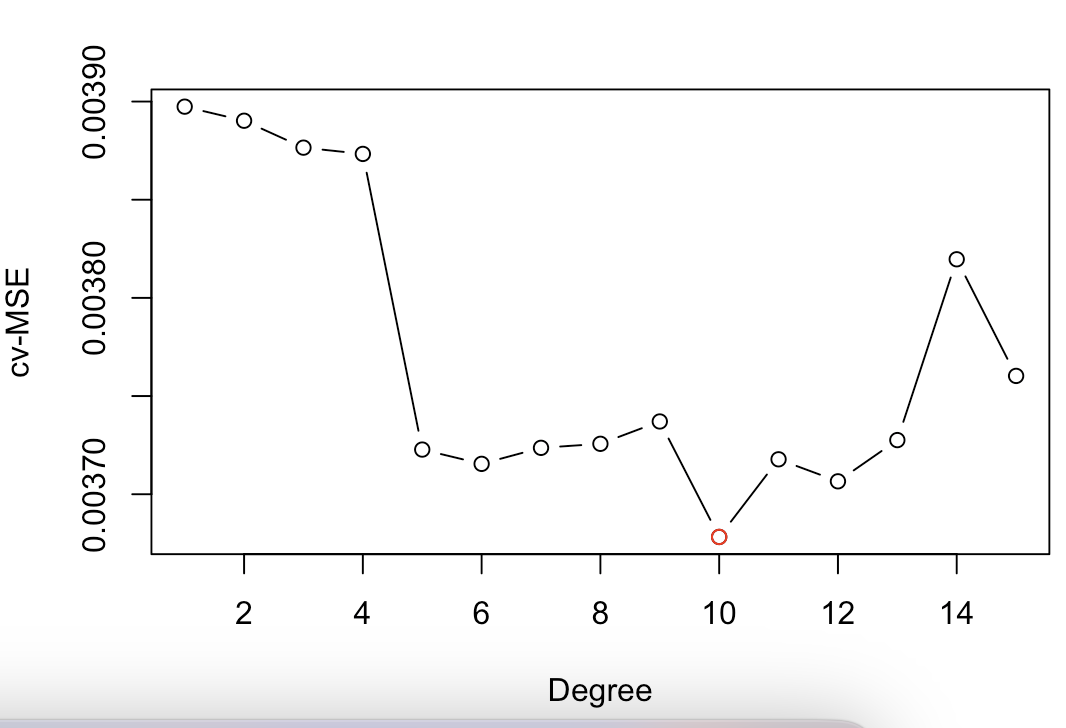
-
完整代码
# 9.(a) library(MASS) model = lm(nox~poly(dis, 3), data = Boston) summary(model) plot(Boston$dis, Boston$nox, xlab="Dis", ylab="Nox") dis_seq = seq(min(Boston$dis), max(Boston$dis), length.out=length(Boston$dis)) ## 设置平滑的dis序列 nox_pred = predict(model, newdata = data.frame(dis=dis_seq)) ## 进行预测 lines(dis_seq, nox_pred, col="red") ## 绘制三次回归预测图像 # 9.(b) rss = numeric(10) # 10个参数的向量(数组) plot(Boston$dis, Boston$nox, xlab="Dis", ylab="Nox", col="grey") colors = rainbow(10) # 10种颜色 dis_seq = seq(min(Boston$dis), max(Boston$dis), length.out=length(Boston$dis)) for(i in 1:10) { model = lm(nox ~ poly(dis, i), data = Boston) nox_pred = predict(model, newdata = data.frame(dis=dis_seq)) lines(dis_seq, nox_pred, col=colors[i], lwd=2) rss[i] = sum(residuals(model)^2) } legend("topright", legend = 1:10, col=colors, lwd=2, cex=0.5) plot(1:10, rss, xlab="Degree", ylab="RSS", type="b") # 9.(c) library(boot) set.seed(1) cv.mse = numeric(10) for(i in 1:10) { glm.fit = glm(nox~poly(dis, i), data=Boston) cv.mse[i] = cv.glm(Boston, glm.fit, K=10)$delta[1] } plot(1:10, cv.mse, xlab="Degree", ylab="cv-MSE", type="b") points(which.min(cv.mse), min(cv.mse), pch=1, col="red") ## 找到使MSE最小的阶数 ## 在图中可以看出当阶数为4的时候交叉验证均方误差最小,所以4阶模型最优 # 9.(d) library(splines) ## 当前自由度(df)要求为4,如果选择3阶(三次样条),那么结点数量为4-3=1个 ## 这里我们选择结点放在中位数位置 knots = quantile(Boston$dis, probs=0.5) knots model = lm(nox ~ bs(dis, df=4, knots=knots), data = Boston) summary(model) dis_seq = seq(min(Boston$dis), max(Boston$dis), length.out=length(Boston$dis)) nox_pred = predict(model, newdata = data.frame(dis=dis_seq)) plot(Boston$dis, Boston$nox, xlab="Dis", ylab="Nox", col="grey") lines(dis_seq, nox_pred, col="red", lwd=2) # 9.(e) # 选择df=4~10的区间 rss = numeric(10) plot(Boston$dis, Boston$nox, xlab="Dis", ylab="Nox", col="grey") colors = rainbow(7) # 10种颜色 dis_seq = seq(min(Boston$dis), max(Boston$dis), length.out=length(Boston$dis)) for(i in 4:10) { model = lm(nox ~ bs(dis, df=i), data = Boston) nox_pred = predict(model, newdata = data.frame(dis=dis_seq)) lines(dis_seq, nox_pred, col=colors[i-3], lwd=2) rss[i] = sum(residuals(model)^2) } legend("topright", legend = 4:10, col=colors, lwd=2, cex=0.5) plot(4:10, rss[4:10], xlab="Degree", ylab="RSS", type="b") ## 随着df增加,模型拟合效果更好,RSS更低(但是可能出现过拟合) # 9.(f) set.seed(1) cv.mse = numeric(15) for(i in 1:15) { glm.fit = glm(nox~bs(dis, df=i), data=Boston) cv.mse[i] = cv.glm(Boston, glm.fit, K=10)$delta[1] } plot(1:15, cv.mse, xlab="Degree", ylab="cv-MSE", type="b") points(which.min(cv.mse), min(cv.mse), pch=1, col="red") ## 由图中可以得出阶数为10的时候交叉验证均方误差最小,拟合效果最好
7.9.10
-
(a)
# 10.(a) library(ISLR) set.seed(1) n = nrow(College) ## 数据总数 p = ncol(College) - 1 ## 最大维度 train = sample(1:n, size=round(0.7*n)) College.train = College[train, ] College.test = College[-train, ] library(leaps) model_forward = regsubsets(Outstate~., data=College.train, nvmax=p, method="forward") model_forward_summary = summary(model_forward) par(mfrow=c(2,2)) plot(1:p, model_forward_summary$cp, xlab="Degree", ylab="Cp", type="o") points(which.min(model_forward_summary$cp), min(model_forward_summary$cp), col="red", pch=16) plot(1:p, model_forward_summary$bic, xlab="Degree", ylab="BIC", type="o") points(which.min(model_forward_summary$bic), min(model_forward_summary$bic), col="red", pch=16) plot(1:p, model_forward_summary$adjr2, xlab="Degree", ylab="AdjR2", type="o") points(which.max(model_forward_summary$adjr2), max(model_forward_summary$adjr2), col="red", pch=16) ## 根据图像可以得出模型大小为13的时候效果最好 coef(model_forward, 13) ## 可以看出包含如列表的13个变量,系数如下
-
(b)
# 10.(b) library(gam) model_gam = gam(Outstate ~ Private + s(Apps) + s(Accept) + s(Top10perc) + s(F.Undergrad) + s(Room.Board) + s(Personal) + s(PhD) + s(Terminal) + s(S.F.Ratio) + s(perc.alumni) + s(Expend) + s(Grad.Rate), data = College.train) par(mfrow=c(3, 5)) plot(model_gam) summary(model_gam) ## 正向影响显著的变量:Private、Apps、Accept、Top10perc、F.Undergrad、Room.Board、Personal、PhD、Terminal、S.F.Ratio、perc.alumni、Expend、Grad.Rate。 ## 具有非线性影响的变量:Accept、Personal、S.F.Ratio、Expend。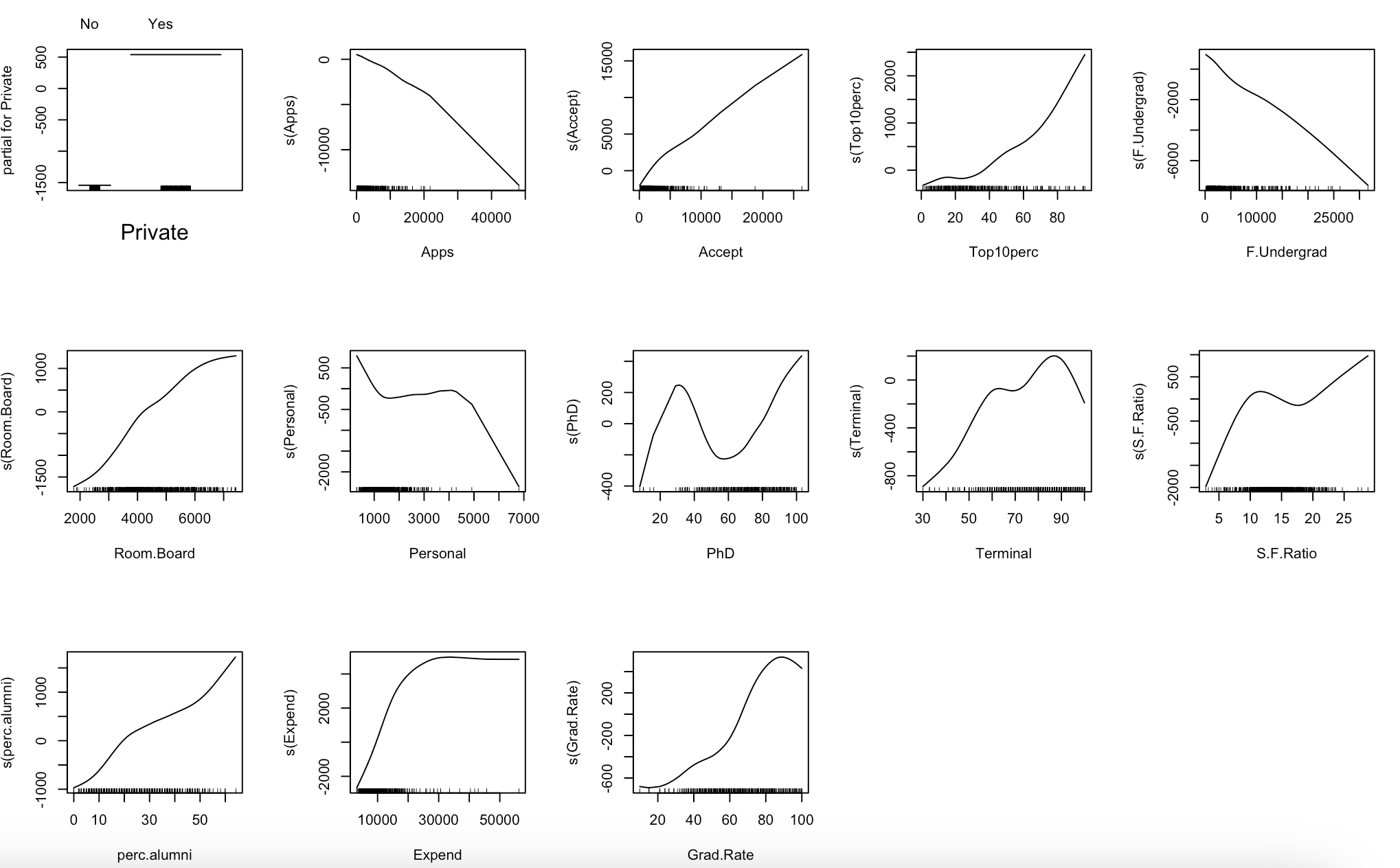
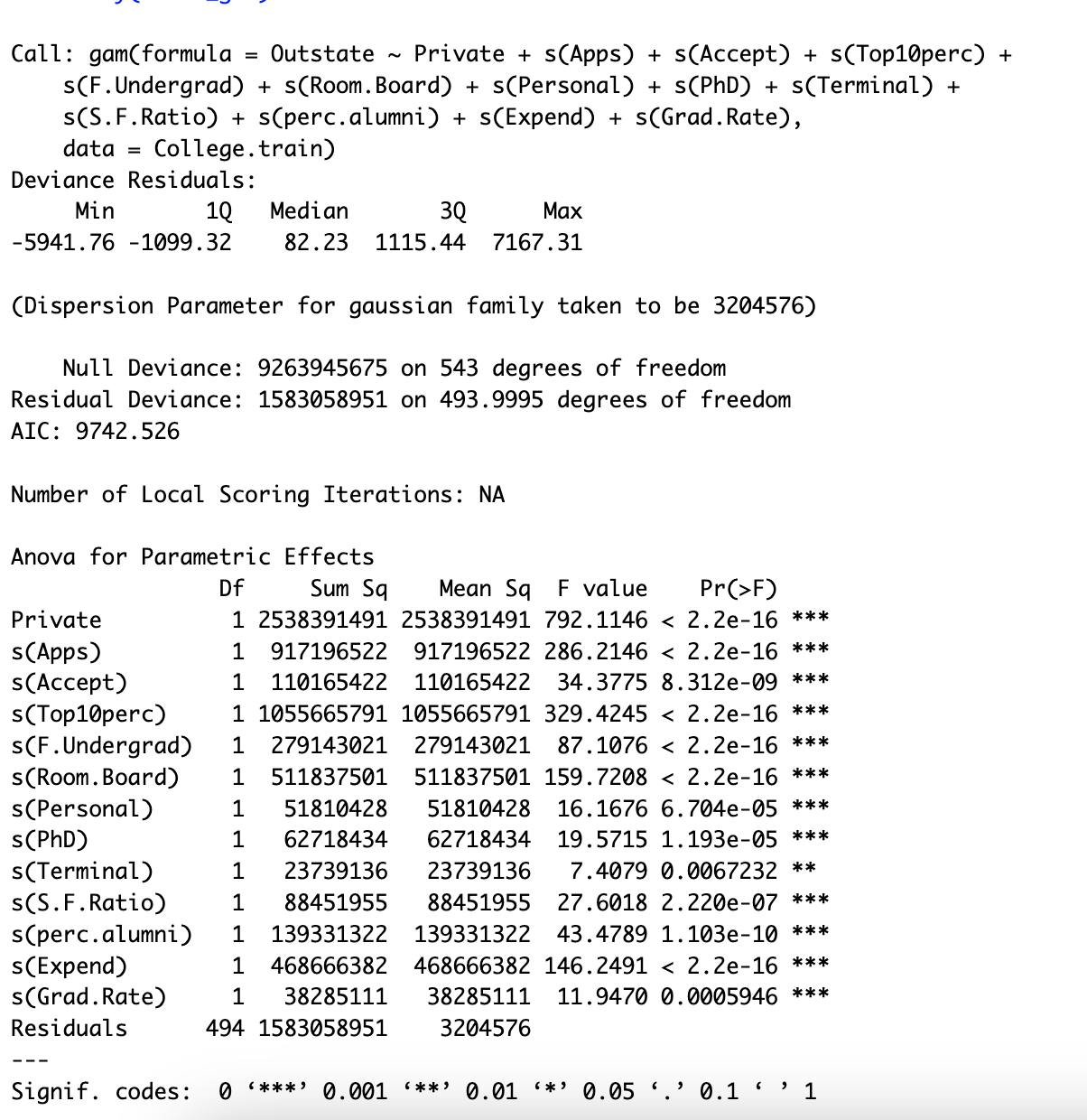
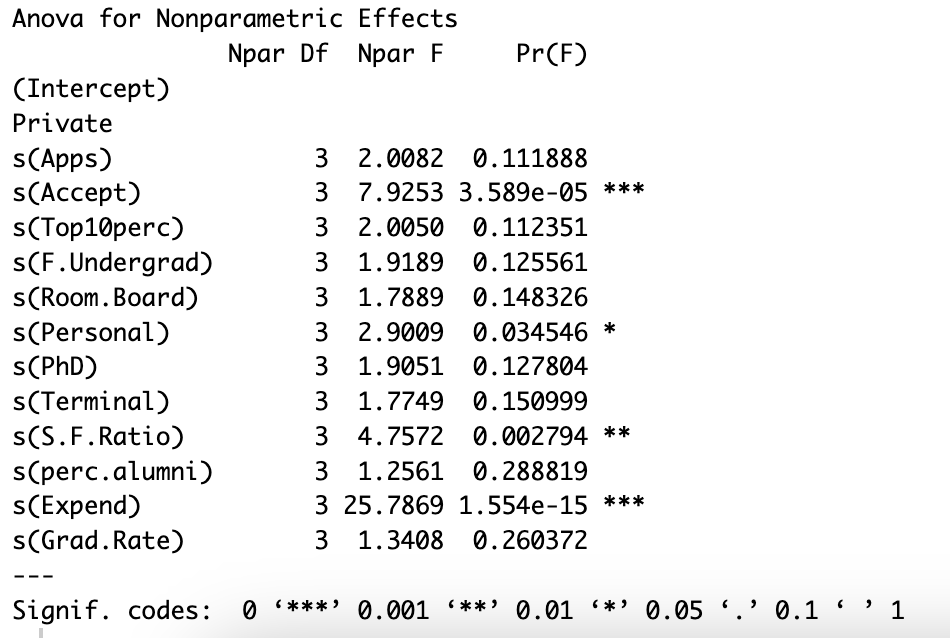
-
(c)
# 10.(c) gam.pred = predict(model_gam, College.test) gam.mse = mean((College.test$Outstate - gam.pred) ^ 2) print(paste("测试集均方误差 (MSE):", round(gam.mse, 2)))
-
(d)
# 10.(d) ## 如(b)中,具有非线性影响的变量:Accept、Personal、S.F.Ratio、Expend。 -
完整代码
# 10.(a) library(ISLR) set.seed(1) n = nrow(College) ## 数据总数 p = ncol(College) - 1 ## 最大维度 train = sample(1:n, size=round(0.7*n)) College.train = College[train, ] College.test = College[-train, ] library(leaps) model_forward = regsubsets(Outstate~., data=College.train, nvmax=p, method="forward") model_forward_summary = summary(model_forward) par(mfrow=c(2,2)) plot(1:p, model_forward_summary$cp, xlab="Degree", ylab="Cp", type="o") points(which.min(model_forward_summary$cp), min(model_forward_summary$cp), col="red", pch=16) plot(1:p, model_forward_summary$bic, xlab="Degree", ylab="BIC", type="o") points(which.min(model_forward_summary$bic), min(model_forward_summary$bic), col="red", pch=16) plot(1:p, model_forward_summary$adjr2, xlab="Degree", ylab="AdjR2", type="o") points(which.max(model_forward_summary$adjr2), max(model_forward_summary$adjr2), col="red", pch=16) ## 根据图像可以得出模型大小为13的时候效果最好 coef(model_forward, 13) ## 可以看出包含如列表的13个变量,系数如下 # 10.(b) library(gam) model_gam = gam(Outstate ~ Private + s(Apps) + s(Accept) + s(Top10perc) + s(F.Undergrad) + s(Room.Board) + s(Personal) + s(PhD) + s(Terminal) + s(S.F.Ratio) + s(perc.alumni) + s(Expend) + s(Grad.Rate), data = College.train) par(mfrow=c(3, 5)) plot(model_gam) summary(model_gam) ## 正向影响显著的变量:Private、Apps、Accept、Top10perc、F.Undergrad、Room.Board、Personal、PhD、Terminal、S.F.Ratio、perc.alumni、Expend、Grad.Rate。 ## 具有非线性影响的变量:Accept、Personal、S.F.Ratio、Expend。 # 10.(c) gam.pred = predict(model_gam, College.test) gam.mse = mean((College.test$Outstate - gam.pred) ^ 2) print(paste("测试集均方误差 (MSE):", round(gam.mse, 2))) # 10.(d) ## 如(b)中,具有非线性影响的变量:Accept、Personal、S.F.Ratio、Expend。
7.9.11
-
(a)
# 11.(a) set.seed(1) x1 = rnorm(100) x2 = rnorm(100) eps = rnorm(100, 0.3) y = -5 + 1*x1 + 3*x2 + eps
-
(b)
# 11.(b) beta1 = 3.14 -
(c)
# 11.(c) beta1 = 3.14 a = y-beta1*x1 beta2 = lm(a~x2)$coef[2] beta2
-
(d)
# 11.(d) a = y-beta2*x2 beta1 = lm(a~x1)$coef[2] beta1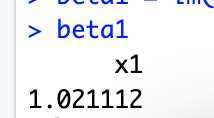
-
(e)
# 11.(e) b1 = rep(NA, 1000) b2 = rep(NA, 1000) b0 = rep(NA, 1000) b1[1] = 3.14 for(i in 1:1000) { a = y-b1[i]*x1 b2[i] = lm(a~x2)$coef[2] b = y-b2[i]*x2 b1[i+1] = lm(b~x1)$coef[2] b0[i] = lm(b~x1)$coef[1] print(paste0("i=", i, " b0=", b0[i], " b1=", b1[i], " b2=", b2[i])) } b1 = b1[-(1001)] par(mfrow=c(1,1)) plot(1:1000, b0, type="l", xlab="iterations", ylab="betas", ylim=c(-5,3), col="green", lwd=2) lines(1:1000, b1, col="blue", lwd=2) # 添加 b1 的线,蓝色 lines(1:1000, b2, col="red", lwd=2) # 添加 b2 的线,红色 legend("center", c("beta0","beta1","beta2"), lty=1, lwd=2, col=c("green","blue","red"))
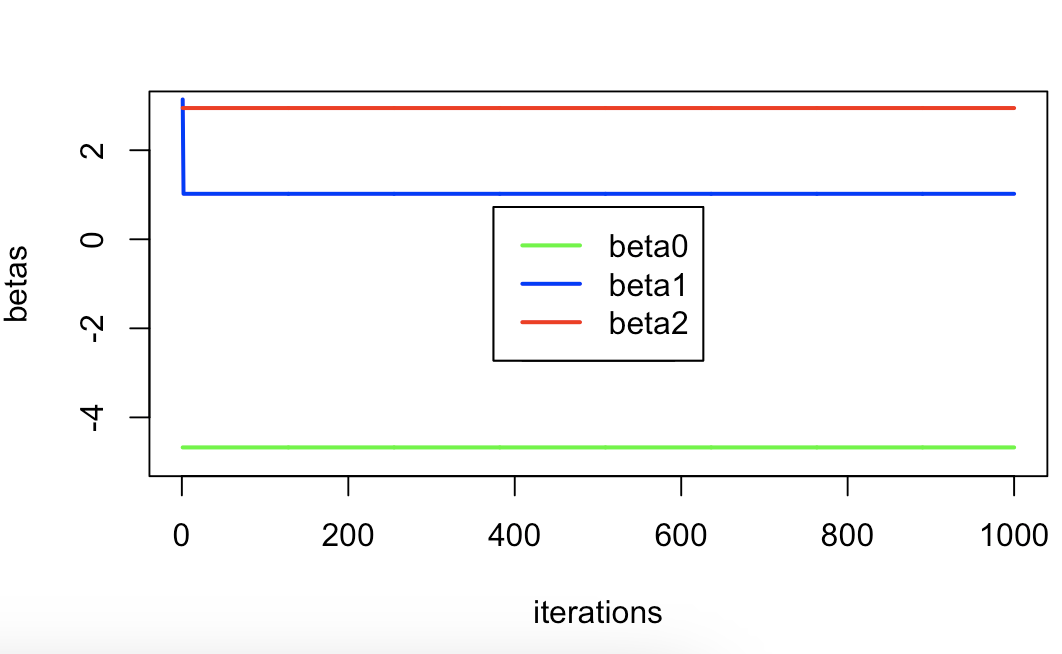
-
(f)
# 11.(f) model = lm(y~x1+x2) print(model$coef) print(paste0(" b0=", b0[1000], " b1=", b1[1000], " b2=", b2[1000])) abline(h=model$coef[1], lty="dashed", lwd=2) abline(h=model$coef[2], lty="dashed", lwd=2) abline(h=model$coef[3], lty="dashed", lwd=2) legend("center", c("beta0","beta1","beta2", "lm"), lty=c(1,1,1,3), lwd=2, col=c("green","blue","red","black"))

-
(g)
# 11.(g) ## 若预测变量与响应变量之间承线性关系,那么少量次数的迭代(1-20次)就可以使参数接近真实值 -
完整代码
# 11.(a) set.seed(1) x1 = rnorm(100) x2 = rnorm(100) eps = rnorm(100, 0.3) y = -5 + 1*x1 + 3*x2 + eps # 11.(b) beta1 = 3.14 # 11.(c) a = y-beta1*x1 beta2 = lm(a~x2)$coef[2] beta2 # 11.(d) a = y-beta2*x2 beta1 = lm(a~x1)$coef[2] beta1 # 11.(e) b1 = rep(NA, 1000) b2 = rep(NA, 1000) b0 = rep(NA, 1000) b1[1] = 3.14 for(i in 1:1000) { a = y-b1[i]*x1 b2[i] = lm(a~x2)$coef[2] b = y-b2[i]*x2 b1[i+1] = lm(b~x1)$coef[2] b0[i] = lm(b~x1)$coef[1] print(paste0("i=", i, " b0=", b0[i], " b1=", b1[i], " b2=", b2[i])) } b1 = b1[-(1001)] par(mfrow=c(1,1)) plot(1:1000, b0, type="l", xlab="iterations", ylab="betas", ylim=c(-5,3), col="green", lwd=2) lines(1:1000, b1, col="blue", lwd=2) # 添加 b1 的线,蓝色 lines(1:1000, b2, col="red", lwd=2) # 添加 b2 的线,红色 legend("center", c("beta0","beta1","beta2"), lty=1, lwd=2, col=c("green","blue","red")) # 11.(f) model = lm(y~x1+x2) print(model$coef) print(paste0(" b0=", b0[1000], " b1=", b1[1000], " b2=", b2[1000])) abline(h=model$coef[1], lty="dashed", lwd=2) abline(h=model$coef[2], lty="dashed", lwd=2) abline(h=model$coef[3], lty="dashed", lwd=2) legend("center", c("beta0","beta1","beta2", "lm"), lty=c(1,1,1,3), lwd=2, col=c("green","blue","red","black")) # 11.(g) ## 若预测变量与响应变量之间承线性关系,那么少量次数的迭代(1-20次)就可以使参数接近真实值
本文是原创文章,采用 CC BY-NC-ND 4.0 协议,完整转载请注明来自 筱柒_Littleseven
评论
匿名评论
隐私政策
你无需删除空行,直接评论以获取最佳展示效果

